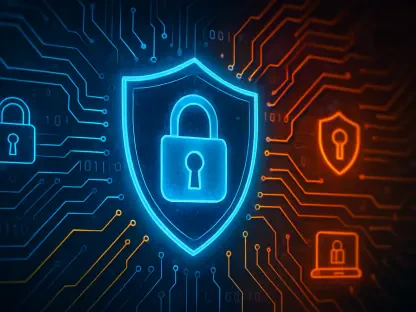In today’s digital landscape, cybersecurity is more critical than ever as cyber threats grow in sophistication and frequency, necessitating constant vigilance and adaptation by individuals and organizations. These threats do not discriminate, affecting everyone from individual users to global enterprises, government entities, and critical infrastructures. Understanding and preparing for these evolving threats is crucial for protecting valuable digital resources and ensuring continuous operational stability.
The digital age has revolutionized personal and professional environments, creating an interconnected web of devices, systems, and data. However, with this interconnectedness comes increased vulnerability as cybercriminal activities escalate, posing a significant challenge to maintaining security. This article explores the dynamics of modern cyber threats and aims to arm readers with critical insights and strategies for effective cybersecurity defenses. From recognizing current threat landscapes to implementing advanced security measures, this comprehensive guide underscores the importance of informed vigilance in navigating the complexities of cyber threats.
Understanding the Current Cyber Threat Landscape
Cybersecurity has transitioned from a specialized concern to a primary focus for many organizations, reflecting the universal impact of cyber threats on modern digital safety. The prevalence of sophisticated cybercriminal activities highlights the pressing need to comprehend the intricate nature of these threats and their potential implications. Cybercriminals are continually advancing their tactics, employing complex techniques that are capable of compromising critical infrastructures and confidential data.
The pervasiveness of cyber threats is evident as governments, major corporations, and individuals alike find themselves targeted by malicious actors. Constant efforts to breach defenses mean that no entity can consider itself exempt from these dangers. This climate of uncertainty demands a deeper understanding of the current threat landscape, emphasizing the role of comprehensive and proactive security strategies in safeguarding both organizational and personal interests. With cyber threats steadily becoming more sophisticated, a robust awareness of their nature and capabilities has never been more essential.
Major Cyber Threat Categories
In the digital realm, malware remains one of the most prevalent and varied threats that can cause extensive damage if not adequately addressed. Over time, malware has diversified into multiple forms, including ransomware, which encrypts files and demands a ransom for their return; spyware, which secretly gathers user information; and cryptojacking, which hijacks a user’s system resources to mine cryptocurrency. Each of these threats poses significant risks to both individuals and organizations, demanding ongoing vigilance to mitigate potential damage.
Phishing attacks represent another major category of cyber threats, relying on deception to compromise security. These attacks commonly involve crafting fraudulent emails or websites to trick individuals into divulging confidential information, such as passwords and financial details. Often preying on human error and trust, phishing attacks can lead to serious repercussions, including data breaches and identity theft. Recognizing the tactics used in phishing schemes is imperative for preventing such incidents and ensuring personal and organizational security. By understanding these threat categories, individuals and organizations can better prepare themselves to combat cyber risks.
The Impact on Critical Infrastructure
Recent incidents have underscored the vulnerabilities within critical infrastructures that cyberattacks can exploit, highlighting the potential for severe consequences. Power grids, transportation systems, and healthcare facilities are among the essential services that could experience significant disruption from cyber intrusions. Such attacks pose not only an operational threat but also affect national security and public safety, emphasizing the need for robust security measures in these critical areas.
The ramifications of attacks on critical infrastructure can be devastating, leading to prolonged service interruptions and widespread chaos. The critical nature of these services means that ensuring their security is a paramount concern for governments and organizations alike. Cybersecurity measures must evolve alongside emerging threats to protect critical infrastructures from potential attacks. Advances in technology and security protocols play a crucial role in fortifying these vital systems, ensuring the continuity of essential services and preventing any catastrophic fallout from cyberattacks.
Identifying Vulnerabilities in Systems
Vulnerabilities within software and hardware systems present significant entry points for cyber attackers. Unpatched systems or outdated protocols often serve as weak links that can easily be exploited by malicious actors seeking unauthorized access to sensitive data. The constant evolution of technology brings about new vulnerabilities that require immediate attention and rectification to prevent security breaches.
To mitigate these risks, organizations must adopt comprehensive approaches to vulnerability management. Conducting regular audits, assessments, and penetration testing enables the identification of weaknesses before they can be exploited. It is essential to maintain regular updates and patching schedules for all systems to address known vulnerabilities promptly. Through proactive measures, organizations can enhance their resilience against cyber threats, safeguarding critical information and maintaining system integrity.
Innovations in Defensive Strategies
As cyber threats become increasingly sophisticated, traditional security measures may prove inadequate in ensuring comprehensive protection. The emergence of innovative solutions such as zero-trust architecture offers the potential for significantly enhanced security. Zero-trust models operate on the principle of never assuming safety, requiring continuous verification of user identity and stringent monitoring of network activity.
Integrating advanced solutions into organizational security strategies can bolster defenses, offering real-time insights into potential threats and minimizing the risk of unauthorized access. These modern approaches prioritize end-to-end security, focusing on the authenticity of users and devices accessing network resources. By adopting contemporary strategies and leveraging technological advancements, organizations can stay ahead of the rapidly evolving cyber threat landscape and ensure robust protection of their digital assets.
Essential Cybersecurity Measures
Securing digital assets necessitates a comprehensive, multi-faceted approach that integrates various cybersecurity measures. Regular software updates and effective patch management are fundamental elements for maintaining secure systems, addressing vulnerabilities as soon as they are discovered. Additionally, implementing robust access controls and encryption standards further fortifies data protection against potential cyber threats.
Education and awareness are also crucial in the successful implementation of cybersecurity measures. Training employees on recognizing phishing attempts and understanding cybersecurity best practices can significantly reduce the likelihood of breaches resulting from human error. A conscious effort to foster a security-focused culture within organizations helps in minimizing risks and establishing a proactive stance against cyber threats. Ensuring that cybersecurity measures are kept current and reflective of emerging threats is essential for the long-term protection of valuable digital resources.
Collaborative Efforts in Cyber Defense
In the fight against cybercrime, collaboration between public and private sectors is indispensable. Law enforcement agencies, cybersecurity experts, and organizations must work in tandem to dismantle cybercrime networks and share critical intelligence. This coalition fosters a concerted effort to counteract cyber threats, enhancing overall cybersecurity and resilience against malicious activities.
International cooperation also holds significant importance in the realm of cyber defense. As cyber threats know no borders, global partnerships allow for the sharing of crucial information, thus facilitating a cohesive and coordinated response. By uniting efforts, nations and organizations can effectively combat the global threat posed by cybercrime. Through these collaborative actions, the collective defense capabilities against cyber threats can be significantly bolstered, contributing to a safer digital environment.
Technological Advancements in Security
Cybersecurity is a field marked by continuous evolution, driven by technological advancements that provide innovative tools and methodologies to counter emerging threats. Entities like Microsoft are pioneering efforts towards passwordless authentication, reducing the reliance on traditional passwords and enhancing overall security through more sophisticated authentication methods. These advancements play a crucial role in adapting security protocols to meet the demands of an ever-changing digital landscape.
The technological progress in cybersecurity extends beyond authentication, embracing innovations like artificial intelligence and machine learning to bolster defense mechanisms. These technologies can detect atypical patterns and respond to threats with unprecedented speed, supplying continuous protection against malicious activities. As technology advances, security protocols must evolve to remain effective, ensuring the protection of digital assets and facilitating a secure digital environment amidst the ever-present threat of cybercrime.
Addressing Data Breaches
The occurrence of recent high-profile data breaches highlights the pressing need for stringent data protection measures. These breaches can result in substantial reputational damage and financial loss, serving as a stark reminder of the critical importance of safeguarding sensitive information. It is imperative for organizations to implement comprehensive security frameworks that prevent unauthorized access to data.
Ensuring that data is adequately protected involves adopting robust encryption methods, securing backups, and routinely monitoring systems for potential breaches. By focusing on data protection measures as a cornerstone of cybersecurity, organizations can mitigate the risks posed by data theft and bolster their defenses against cyber threats. The rise in data breaches underscores the need for diligent adherence to security protocols, illustrating their vital role in preserving both organizational integrity and client trust.
Preparing for Future Threats
As cyber threats continue to advance and diversify, preparedness remains a key component of effective cybersecurity strategy. Developing a comprehensive incident response plan is a crucial step for organizations seeking to respond swiftly and effectively to potential breaches, minimizing damage and expediting recovery processes. By preparing for the unknown, entities can solidify their defenses and ensure continuity in the face of evolving threats.
Staying informed about emerging cyber threats and continuously evaluating existing security measures is essential in adapting to future challenges. Organizations should regularly reassess their defense strategies to incorporate new developments in technology and intelligence. By maintaining an adaptable stance, entities can effectively position themselves to manage the uncertainties of future cyber threats, ensuring resilient and robust systems capable of withstanding and countering potential risks.
Promoting a Culture of Cyber Awareness
Fostering a culture of cybersecurity awareness within organizations is foundational for minimizing cyber risks. Educating employees and stakeholders about potential threats and implementing training programs can significantly reduce the likelihood of security breaches. Encouraging responsible online behaviors and vigilance in recognizing potential threats cultivates an environment of heightened security consciousness.
Embedding cybersecurity into the organizational culture means nurturing an ongoing commitment to enhancing security measures and staying informed about cyber threats. By prioritizing education and awareness, organizations can build defenses that extend beyond technological solutions, creating a vigilant and prepared community capable of navigating the complexities of the digital realm. This approach ensures that cybersecurity measures are integrated into everyday practices, establishing a strong foundation for enduring security.
The Ongoing Battle Against Cybercrime
The dynamic nature of cyber threats necessitates an ongoing commitment to the battle against cybercrime, requiring vigilance, adaptability, and a collaborative spirit. Organizations must continuously refine their defenses against evolving threats, ensuring that their security strategies remain relevant and effective in countering sophisticated malicious activities. The cyber landscape demands proactive measures that align technological advancements with strategic policymaking.
The fight against cybercrime transcends individual efforts, calling for a collective responsibility shared among all stakeholders, from industry leaders to everyday users. Maintaining a state of preparedness fosters resilience, ensuring that digital environments are robust enough to endure the challenges posed by cyber threats. By nurturing a collaborative approach and integrating innovative solutions, comprehensive cybersecurity measures can be established, safeguarding critical infrastructures and digital assets from the pervasive threat of cyber adversaries.









